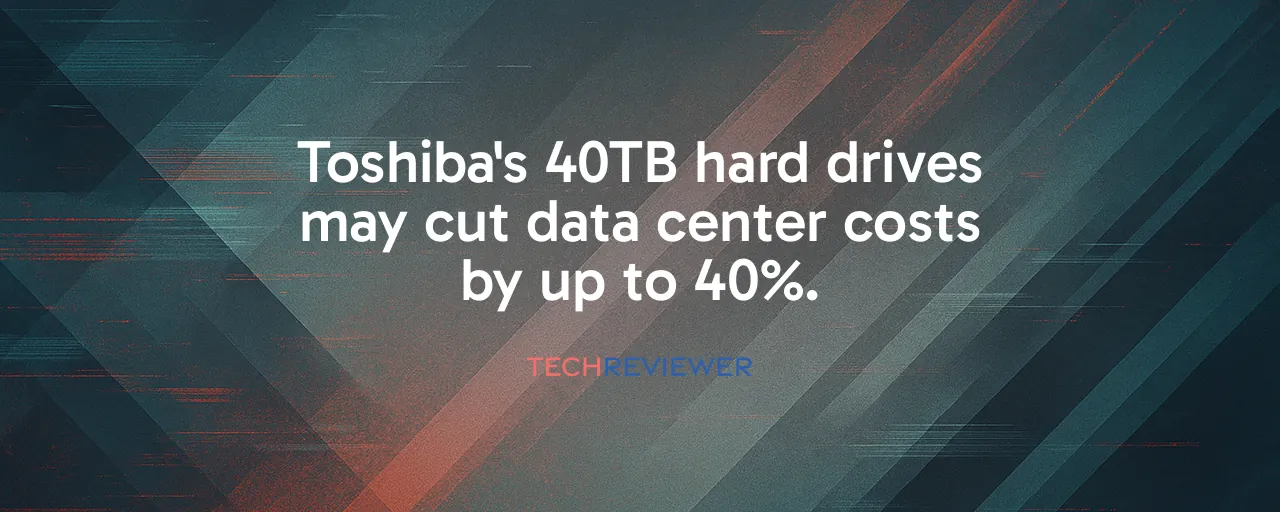A Leap in Storage Capacity
Toshiba just pulled off a feat that could make data centers rethink their storage game. By stacking 12 disks into a standard 3.5-inch hard drive, the company verified a path to 40TB drives by 2027, a 20 percent jump over today's 10-disk standard. This isn't just about cramming more platters into a drive; it's a clever mix of engineering tricks, like swapping aluminum for thinner, sturdier glass substrates and pairing them with Microwave-Assisted Magnetic Recording (MAMR). These advancements let Toshiba pack more data into the same space, addressing the skyrocketing storage needs of cloud services and AI training datasets. With data centers gobbling up capacity like never before, this breakthrough feels like it came out of nowhere to keep hard drives in the race.
Why Hard Drives Still Matter
You might think solid-state drives (SSDs) have taken over, with their lightning-fast speeds dominating laptops and phones. But in hyperscale data centers, where companies like Amazon Web Services and Google Cloud store petabytes of data, hard drives hold a trump card: cost. HDDs offer a six-to-one price advantage per terabyte over SSDs, a gap that's likely to stick through 2027. Toshiba's 40TB drives could slash infrastructure costs by 30-40 percent compared to current 30TB models, letting operators store more in less space. This matters when you consider that global data center power demand is set to jump 50 percent by 2027, driven by AI workloads that need vast storage for training datasets.
Real-World Impact: Cloud vs. Media Archives
To see how this plays out, look at hyperscale cloud providers like Microsoft Azure. They've deployed hundreds of petabytes of HDDs for object storage, balancing speed and cost to keep services like cloud backups affordable. Toshiba's 40TB drives could let them shrink server racks while handling the same data, cutting power and cooling costs. Compare that to media companies, like those running video archives for streaming platforms. These firms rely on HDDs for long-term storage of massive content libraries, where access speed matters less than keeping costs low. Toshiba's tech gives them breathing room to store decades of high-resolution video without breaking the bank. Both cases show how higher-capacity drives translate to real savings, though cloud providers prioritize density while media firms lean on affordability.
The Tech Behind the Leap
Toshiba's breakthrough hinges on a few key innovations. Glass substrates, already proven in smaller laptop drives, are 40 percent thinner than aluminum, letting engineers squeeze in two extra platters. These glass disks resist warping and handle heat better, critical for the nanometer precision needed in modern drives. MAMR, meanwhile, uses microwave fields to make data writes easier, boosting capacity without the complexity of laser-based Heat-Assisted Magnetic Recording (HAMR), which Seagate is betting on for its 36TB drives. Toshiba's approach isn't flawless, as 12 platters mean trickier vibration control and higher power needs, but it builds on reliable tech, with 31TB MAMR drives already tested in 2024. This sets a foundation for even bigger capacities, maybe 50TB, down the road.
Balancing Progress and Challenges
Not everyone's sold on Toshiba's path. Seagate's HAMR tech already hit 36TB with fewer platters, suggesting it might scale faster to 50TB or beyond. Some data center operators worry about the extra complexity of 12-disk drives, like increased vibration or power demands, which could hit reliability or require pricier infrastructure upgrades. Glass substrates also cost more to produce, which might pinch margins until manufacturing ramps up. On the flip side, HDDs have a smaller carbon footprint per terabyte than SSDs, a win for sustainability as data centers face scrutiny over energy use. With the HDD market projected to hit $111.2 billion by 2035, Toshiba's bet could pay off big if it keeps costs competitive.
What's Next for Storage
Toshiba's 40TB drives are a stepping stone, not the finish line. By 2028, we could see 50-60TB drives as HAMR and other recording tech mature. Data centers will keep blending HDDs for bulk storage with SSDs for speed, matching each to specific workloads. For consumers, this means cheaper cloud services and more room for photos, videos, and games in the cloud. But it's not all smooth sailing, as regulations like GDPR demand secure data handling, and supply chain bottlenecks could slow production. Still, Toshiba's push shows that hard drives, far from obsolete, are evolving to meet the digital world's endless hunger for data.
